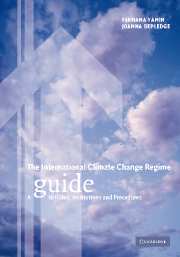Book contents
- Frontmatter
- Contents
- List of figures
- List of tables
- List of boxes
- Foreword by Joke Waller Hunter, Executive Secretary, FCCC
- Preface and acknowledgements
- List of abbreviations
- 1 Introduction
- 2 Overview
- 3 Regime participants
- 4 Objective and principles
- 5 Mitigation commitments
- 6 Flexibility mechanisms
- 7 Research, systematic observation, education, training and public awareness
- 8 Adaptation
- 9 Impacts of response measures
- 10 Finance, technology and capacity-building
- 11 Reporting and review
- 12 Compliance
- 13 Institutions
- 14 The negotiation process
- 15 Scientific and technical input
- 16 Administering the regime
- 17 Linkages
- 18 Evolution of the regime
- 19 Conclusion: taking stock and moving forward
- Appendix I List of Parties, their groups and key statistics
- Appendix II Annex I Party fact sheets: emissions, targets and projections for Annex I Parties and groupings
- Appendix III Table of Articles, issues and COP Decisions
- Bibliography
- Index
15 - Scientific and technical input
Published online by Cambridge University Press: 16 July 2009
- Frontmatter
- Contents
- List of figures
- List of tables
- List of boxes
- Foreword by Joke Waller Hunter, Executive Secretary, FCCC
- Preface and acknowledgements
- List of abbreviations
- 1 Introduction
- 2 Overview
- 3 Regime participants
- 4 Objective and principles
- 5 Mitigation commitments
- 6 Flexibility mechanisms
- 7 Research, systematic observation, education, training and public awareness
- 8 Adaptation
- 9 Impacts of response measures
- 10 Finance, technology and capacity-building
- 11 Reporting and review
- 12 Compliance
- 13 Institutions
- 14 The negotiation process
- 15 Scientific and technical input
- 16 Administering the regime
- 17 Linkages
- 18 Evolution of the regime
- 19 Conclusion: taking stock and moving forward
- Appendix I List of Parties, their groups and key statistics
- Appendix II Annex I Party fact sheets: emissions, targets and projections for Annex I Parties and groupings
- Appendix III Table of Articles, issues and COP Decisions
- Bibliography
- Index
Summary
Introduction
Access to the best available, most up-to-date scientific and technical information is of critical importance to the climate change regime. The IPCC plays a vital role in the climate change regime by providing important scientific and technical input. The demand for such input has grown as the regime has matured, especially with the adoption of the Kyoto Protocol and the new issues that it introduced. This chapter examines the institutional channels through which the climate change regime receives scientific and technical input, and how this input is then considered in the negotiations. It begins with a brief overview of the role of the SBSTA as the regime's scientific and technical body, before focusing on the IPCC as the regime's predominant source of scientific and technical information. The chapter then touches upon the contribution of the regime's roster of experts, the Secretariat, other IGOs and NGOs.
The Subsidiary Body for Scientific and Technological Advice
The main institutional channel for transmitting scientific input to the climate change regime is through the SBSTA, whose mandate is to ‘provide the COP with timely information and advice on scientific and technological matters relating to the Convention’. The SBSTA, however, consists of an open-ended body of government delegates representing national interests, rather than a select group of impartial experts. It therefore serves as a political negotiating forum on issues with significant scientific and technical content rather than a scientific assessment body.
- Type
- Chapter
- Information
- The International Climate Change RegimeA Guide to Rules, Institutions and Procedures, pp. 464 - 486Publisher: Cambridge University PressPrint publication year: 2004



